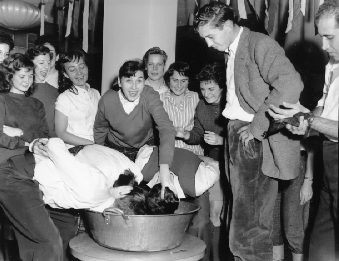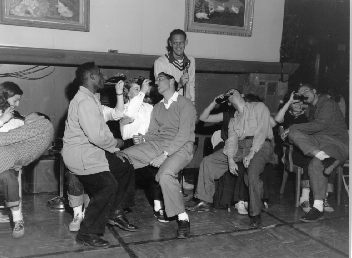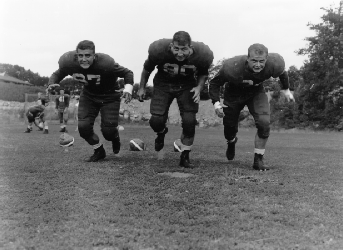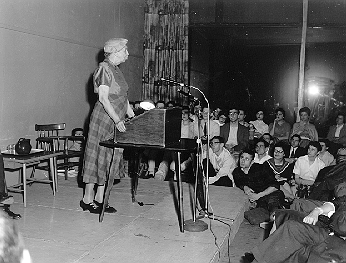The First Decade

 Brandeis University campus, 1948
Brandeis University campus, 1948
The need to overcome three basic challenges dominated Brandeis’ first several years as a functioning institution: constructing a campus, hiring faculty, and attracting students. In some respects, the first of these came last; for the first few years, the buildings that were the legacy of Middlesex University served Brandeis needs adequately, if uncomfortably. Middlesex’s most imposing structures, John Hall Smith’s beloved ‘Irish’ Castle and the brick academic building that housed the veterinary school, were modified to serve as living or office space, lecture halls and labs, classrooms and cafeterias.
 A few years later (take a closer look)
A few years later (take a closer look)
Other Middlesex buildings forming the initial core of the Brandeis campus included “the Worm,” a single-story, curved building that housed the campus bookstore, and converted stables that served as the first university library. The white cottage that had been John Hall Smith’s on-campus residence as Middlesex President was adopted as the first home of the Brandeis administration and officially renamed Woodruff Hall. Perhaps inevitably, it came to be known as “the White House.” A wishing well and apple orchard on the hill behind the castle completed the picturesque landscape. Only the former veterinary school, now Ford Hall, and the Castle (registered as a national landmark) survive as reminders of Middlesex University, the almost continual need for space having compelled the sometimes difficult decision to replace the older buildings with facilities better suited to Brandeis’ ambitious mission.
Recruiting faculty to the new university proved a less troublesome matter than one might expect. A variety of motives brought capable people to teach and work at Brandeis. Some had been associated with Middlesex University, like former dean of liberal arts Joseph Cheskis. C. Ruggles Smith, who had taken over as president of Middlesex University after his father’s death, stayed on to become Brandeis University’s first registrar. Some younger scholars and scientists, like chemist Saul Cohen, saw in America’s first Jewish-sponsored university opportunities for academic advancement that were far from certain at institutions still chary of admitting too many Jews into the ranks of their faculty.
At the other end of the spectrum, Brandeis profited by offering a home to eminent academics such as the literary scholar Ludwig Lewisohn, forced from their positions by then-current retirement regulations. Still others, like the young Boston-born composer and conductor Leonard Bernstein, must have been attracted by the romance of the whole enterprise. Among them, these and other representatives of Brandeis’ first generation faculty established a lasting, distinctive tradition of excellence and commitment.
Like the campus itself, the first Brandeis students were a quirky lot. The decision had been to build the student body from the ground up, so to speak, admitting only a new freshman class for each of the first four years. One hundred and seven students enrolled as members of the first class, the class of ’52. They were iconoclastic and contrarian almost by necessity, willing to entrust their education to an institution with no academic track record (and, until 1953, no accreditation). For many of them, this Jewish-sponsored university offered a welcome unavailable at the country’s most prestigious campuses, where enrollment quotas limited the number of Jews admitted, qualifications notwithstanding.
The campus where these new students lived and worked, though charmingly rustic, still bore the marks of previous neglect, and they had to adapt to an environment in a state of non-stop alteration. Crossing mudpits straddled by wooden planks as they made their way from dormitory to classroom and back, passing construction sites that seemed to migrate from one part of campus to another, they came to think of themselves, in the trademark Brandeis compound of pride and irony, as “pioneers.”

A Closer Look at an Aerial View of the Campus in the mid-1950s













